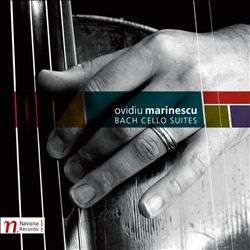|
Back
01/26/2013
Johann Sebastian Bach: Six Suites for Violoncello Solo
Ovidiu Marinescu (cello)
Recorded at Rose Recital Hall in the Fisher Bennett, University of Pennsylvania, Philadelphia (May 22/31, August 16/30, November 25, 2009, and January 10, 2010) – 130’24
Navona Records NV5840 – Disc 1 CD ROM contains program notes, bio, musical score, and other enhanced media

   
Johann Sebastian Bach’s six suites for cello are among the most frequently recorded works in the entire cello repertoire. Every major and many less well-known cellists have made recordings of these suites and some cellists have made multiple recordings. Hungarian cellist Janos Starker has made no less than six recordings throughout his career, and all of them have been distinguished and contain different insights into his various interpretations. These cello suites are those kinds of compositions, which have puzzled and intrigued musicians for generations, and continue to do so.
Bach did not play the cello. We know he was an excellent keyboard performer, and indeed, many passages within the cello suites seemed to have been composed for the keyboard, and this fact alone has lead cellists to ponder the phrasings and bowings, which are so different in so many passages in this vast catalogue of so many recordings. It has obviously intimidated many of the great cellists from approaching them in the recording studio. Both Mstislav Rostropovich and Pablo Casals waited until very late in their careers to document their interpretations in a recording.
And now we have this latest recording by Rumanian cellist Ovidiu Marinescu on the Navona label for PARMA recordings. It has a lot to commend and holds itself well against so many other superb and historic documents of these suites. I particularly like the fact that as Mr. Marinescu plays on a modern instrument, not a baroque cello, he does not make any effort to have his cello sound like a baroque instrument. Marinescu plays with a full and vibrantly luscious tone, singing through the long lines and filigreed phrases like a great contralto or bass-baritone. He has an astonishingly accurate intonation, with clean attacks centered squarely on pitch without leaning or scooping up to notes, which is so annoying and practiced by so many cellists. This habit is merely a bad tradition left over from the 19th Century.
Marinescu bases his performance on many various editions. His judgments are well informed academically with the current musicology, and he presents what he feels comes closest to Bach’s original intentions based on what we now know, including for instance, two preludes which can replace the Gigue in Suite no. 2 as two alternate endings. Another bonus of this new recording is Navona has this CD also work as a DVD. When you insert this disc into your computer you will see that it not only contains superb program notes on the performance history of the cello suites, bios and other enhanced media, but there is also a complete musical score to the edition that Mr. Marinescu is playing. I do not own a score of the Bach cello suites and found this bonus most enjoyable, as I was able to follow the music while listening to it.
This is a feature that musicians will truly appreciate.
If you do not own a recording of the Bach cello suites, I can recommend this performance without any reservations. If you own several, as I do, this will prove a most worthy and interesting edition to add to your collection.
Micaele Sparacino
|